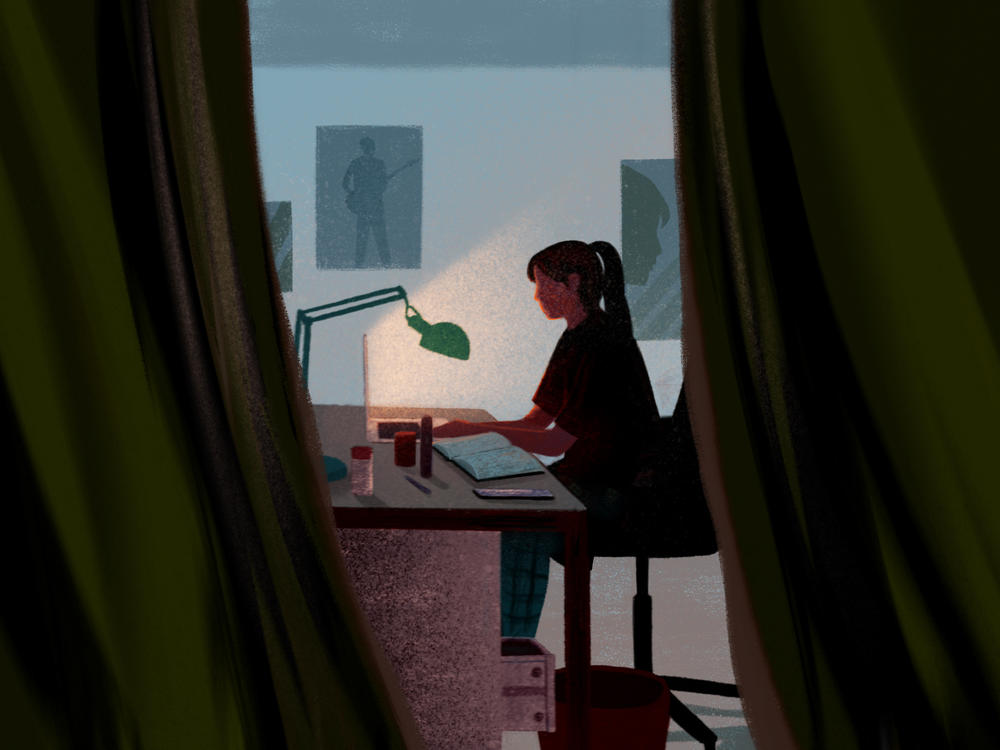Section Branding
Header Content
Why So Many Asian Americans Are Learning Remotely
Primary Content
Last month, Tsong Tong Vang was walking his 5-year-old grandson to the school bus in St. Paul, Minn., when, according to local media reports, a woman pulled up in a car and started yelling anti-Asian abuse and threats at him.
Reports of such incidents have been growing around the country since early last year, amid public statements by President Trump and others linking China with the coronavirus pandemic. And they may be one reason for some Asian families not to send children to school in-person right now.
Asian American students are far more likely to be learning remotely than members of any other racial or ethnic group in the United States. As of February 2021, almost 7 in 10 Asian American K-12 students were still learning online only, according to the U.S. Education Department's latest school survey. That's 12 points higher than Hispanic students, 15 points higher than Black students, and 45 points higher than white students.
Some of that gap may be because a large number of the nation's Asian students live in California, where most public schools remained closed in February. But the gap holds across the Northeast, the Midwest and the South, suggesting that Asian students are choosing to stay remote even where there are in-person options.
"I think it is striking that Asian-Americans are so hesitant to send their kids back to school," says Russell Jeung, professor of Asian American studies at San Francisco State University and co-founder of the group Stop AAPI Hate. They published a report last fall in which youths detailed hundreds of incidents of harassment and physical assault.
Jeung and other experts say anti-Asian racism and even violence, as exemplified by the Atlanta-area mass shooting last month, may be keeping some students at home.
"Concern about the pandemic, plus the concern over the racism that their kids may experience on the way to school or within the classroom," Jeung says, "are both major issues to sending your kid back to school."
OiYan Poon agrees. She's an expert in the racial politics of education, access and Asian-Americans, at the University of Illinois at Chicago.
"I know plenty of people, including myself, who experienced this kind of racialized bullying in schools as children," she said. "And as a parent to a young child in public school systems, I'm not comfortable, personally, now with sending my child in to school for that reason."
Poon, Jeung and other experts say that, beyond the rise in anti-Asian racism, there are other reasons that Asian-Americans may be staying home from school in larger numbers than others. They are more likely than any other racial or ethnic group to live in intergenerational households, making them potentially more worried about putting grandparents at risk from COVID-19, while also providing more adults who can help balance the demands of work and remote learning.
And, says Poon, "Asian-Americans tend to be a very transnational population, meaning that the majority of this population is immigrant or has immigrant ties. "
WIth friends and family living overseas, Poon says, she is looking at the experience of places like South Korea or Taiwan where they are "living their best life," having brought the pandemic well under control. Some Asian Americans may feel that the U.S. is not taking the pandemic seriously enough. "The last few decades, places in Asia have experienced epidemics and have managed things very differently than how the United States has been handling this current pandemic."
Van Tran is a sociologist at the Graduate Center of the City University of New York. His research has found that Asian-Americans are historically more loyal to public schools than other racial and ethnic groups. He points out yet another reason that Asian families may be hesitant to go in person: They are more likely to choose magnet schools which require them to travel longer distances. In New York City, that can mean public transit.
Asian families, Tran says, including his own sibling's, are sharing information over WhatsApp and on social media, and concluding that New York City's schools are just not physically safe right now.
And that, he adds, is a real loss: "It cuts to the very core of trust and among immigrant families, what we call an institutional trust, with the public education system being one of the most important ones that many Asian immigrants encounter upon arriving in the United States."
When New York City recently had another chance for students to opt-in to in-person learning, he said, some families that had already gone back to school in person told their friends and neighbors that it wasn't worth it because of the frequent quarantines.
"And this kind of mismanagement, of the opening and closing of the transition from remote and online that we experienced over the last year has been tremendously disruptive," Tran says.
Tran and other experts worry the educational consequences of this extended time in remote learning could be grim, especially for Asian students who are English language learners.
Poon's 6-year-old daughter is in the Chicago public schools, learning remotely this year. And she agrees it hasn't been ideal. Her daughter sometimes wanders away from Zoom class altogether.
Still, they are debating about what to do in the fall.
"My husband and I have talked about sending our daughter back in physically in September, but we've also said, 'let's see what happens,' " Poon says. "Let's have another check in in August about what that looks like and what that means and how the school is handling things."
She says that rebuilding trust and making public schools feel safe for her family — both physically and emotionally — will take time and effort.
Copyright 2021 NPR. To see more, visit https://www.npr.org.

